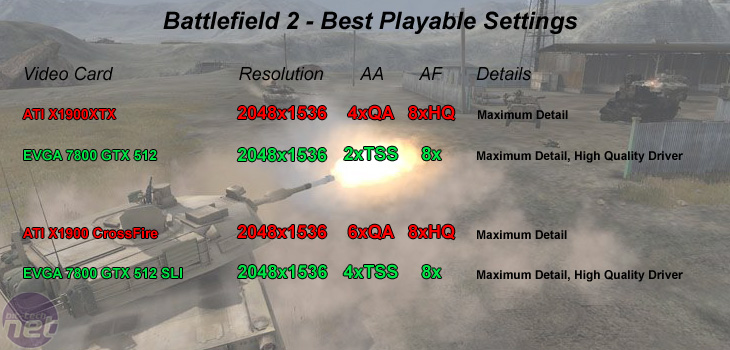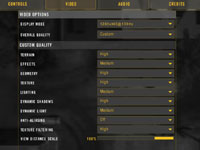Battlefield 2
Publisher: Electronic ArtsBattlefield 2 features an all-new game engine based on the DirectX 9.0 API. There is no Shader Model 3.0 support, but the majority of hardware will use a Shader Model 2.0++ mode that includes support for Normal Maps, Parallax Mapping, Full-Resolution Dynamic Shadowing, Post Processing and Fog.
The game will look the same on both NVIDIA and ATI hardware, so there is no advantage of choosing one over the other in image quality related circumstances. The only major difference is that Ultra Shadow 2 is utilised on NVIDIA's hardware, while the shadowing on ATI hardware is done using a slightly different technique.
We played three five-minute segments of the same map, reporting the median frame rate. We found that there was no ready way to duplicate testing situations manually in this game, so we felt that taking a typical slice of action from the game was the best way to report our findings. We controlled Anti-Aliasing from inside the game, while Anisotropic Filtering was set to 8xAF when the 'Texture Filtering' option was set to 'High'.
Below is a table of the best-playable settings that we found best for each video card configuration. In this title, we found that 25 frames per second minimum and a target of 55 frames per second (or higher) for the average frame rate delivered a good gaming experience on these video cards.


The average frame rate was also considerably higher on the X1900XTX too, meaning that the gameplay experience was much smoother - there was only one instance where the frame rate dropped below 30 frames per second and that was also the only time where the frame rate dropped below 38 fps too. Incidentally, the frame rate on the GTX 512 hovered in and around the 40 fps mark for a lot longer than the Radeon X1900 CrossFire during the course of our manual run through.
The Radeon X1900 CrossFire was capable of playing Battlefield 2 at 2048x1536 6x QAAA 8x HQ AF with no sign of any hitching or choppiness whatsoever - this is the highest we've ever been able to play Battlefield 2 at too. On the other hand the GeForce 7800 GTX SLI configuration was not fast enough to play the game at 8x SAA and 2048x1536 at the same time, despite delivering an average frame rate well above 80 frames per second.

MSI MPG Velox 100R Chassis Review
October 14 2021 | 15:04








Want to comment? Please log in.